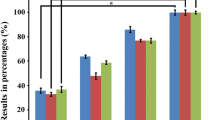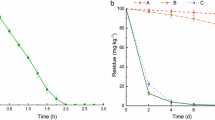Abstract
Enterobacter cloacae AKS7 was previously reported to degrade UV-treated low-density polyethylene (LDPE) more efficiently than UV-untreated LDPE. However, the degradation of LDPE by Enterobacter cloacae AKS7 at the LDPE-contaminated soil remained unaddressed. To address this issue, soil microcosms were prepared in which an equal amount of either UV-treated or UV-untreated LDPE was added. Then, the microcosms were either augmented with AKS7 or left non-augmented. We observed that the bioaugmented microcosms exhibited approximately twofold greater polymer degradation than non-bioaugmented microcosms. To investigate the underlying cause, we found that the abundance of LDPE-degrading organisms got increased by approximately fivefold in bioaugmented microcosms than non-bioaugmented microcosms. The microbial biomass carbon and nitrogen content got enhanced by approximately twofold in bioaugmented microcosms as contrasted to non-bioaugmented microcosms. Furthermore, the bioaugmented microcosms showed almost twofold increase in the level of dehydrogenase and fluorescein diacetate (FDA) hydrolyzing activity than the non-bioaugmented microcosms. To add on, Shannon-diversity index and Gini coefficient were determined in each microcosm to measure the microbial richness and evenness, respectively, using the results of carbon source utilization pattern of BiOLOG ECO plate. The bioaugmented microcosms exhibited ~ 30% higher functional richness and ~ 30% enhanced functional evenness than the non-bioaugmented microcosms indicating the formation of an enriched ecosystem that could offer various functions including polymer degradation. Taken together, the results suggested that Enterobacter cloacae AKS7 could be used as a promising bioaugmenting agent for the sustainable degradation of LDPE waste at a contaminated site.





Similar content being viewed by others
Availability of data and material
The datasets generated during and/or analysed during the current study are available from thecorresponding author on reasonable request.
Code availability
Minitab 19 software was used for the current study. The software happens to be a trial version.
References
Adam G, Duncan H (2001) Development of a sensitive and rapid method for the measurement of total microbial activity using fluorescein diacetate (FDA) in a range of soils. Soil Biol Biochem 33:943–951. https://doi.org/10.1016/S0038-0717(00)00244-3
Al-Salem SM, Abraham G, Al-Qabandi OA, Dashti AM (2015) Investigating the effect of accelerated weathering on the mechanical and physical properties of high content plastic solid waste (PSW) blends with virgin linear low-density polyethylene (LLDPE). Polym Test 46:116–121. https://doi.org/10.1016/j.polymertesting.2015.07.008
Andrady AL, Neal MA (2009) Applications and societal benefits of plastics. Philos Trans R Soc Lond B Biol Sci 364:1977–1984. https://doi.org/10.1098/rstb.2008.0304
Aziz SS (2018) Bioremediation of environmental waste: a review. Univ Wah J Sci Technol 2:35–42. Retrieved from https://www.uwjst.org.pk/index.php/uwjst/article/view/14
Brookes PC, Landman A, Pruden G, Jenkinson DS (1985) Chloroform fumigation and the release of soil nitrogen: a rapid direct extraction method to measure microbial biomass nitrogen in soil. Soil Biol Biochem 17:837–842. https://doi.org/10.1016/0038-0717(85)90144-0
Chakraborty P, Sarker RK, Roy R, Ghosh A, Maiti D, Tribedi P (2019) Bioaugmentation of soil with Enterobacter cloacae AKS7 enhances soil nitrogen content and boosts soil microbial functional-diversity. 3 Biotech 9:1–10. https://doi.org/10.1007/s13205-019-1791-8
Dey S, Tribedi P (2018) Microbial functional diversity plays an important role in the degradation of polyhydroxybutyrate (PHB) in soil. 3 Biotech 8:1–8. https://doi.org/10.1007/s13205-018-1201-7
Epelde L, Mijangos I, Becerril JM, Garbisu C (2009) Soil microbial community as bioindicator of the recovery of soil functioning derived from metal phytoextraction with sorghum. Soil Biol Biochem 41:1788–1794. https://doi.org/10.1016/j.soilbio.2008.04.001
Esmaeili A, Pourbabaee AA, Alikhani HA, Shabani F, Esmaeili E (2013) Biodegradation of low-density polyethylene (LDPE) by mixed culture of Lysinibacillus xylanilyticus and Aspergillus niger in soil. PLoS ONE 8:e71720. https://doi.org/10.1371/journal.pone.0071720
Fotopoulou KN, Karapanagioti HK (2017) Degradation of various plastics in the environment. In: Takada H, Karapanagioti H (eds) Hazardous chemicals associated with plastics in the marine environment. The handbook of environmental chemistry, vol 78. Springer, Cham, pp 71–92
Gu Y, Wag P, Kong C (2009) Urease, invertase, dehydrogenase and polyphenoloxidase activities in paddy soils influenced by allelophatic rice variety. Eur J Soil Biol 45:436–441. https://doi.org/10.1016/j.ejsobi.2009.06.003
Hadad D, Geresh S, Sivan A (2005) Biodegradation of polyethylene by the thermophilic bacterium Brevibacillus borstelensis. J Appl Microbiol 98:1093–1100. https://doi.org/10.1111/j.1365-2672.2005.02553.x
Hahladakis JN, Velis CA, Weber R, Iacovidou E, Purnell P (2018) An overview of chemical additives presents in plastics: Migration, release, fate and environmental impact during their use, disposal and recycling. J Hazard Mater 344:179–199. https://doi.org/10.1016/j.jhazmat.2017.10.014
Herrero M, Stuckey DC (2015) Bioaugmentation and its application in wastewater treatment: a review. Chemosphere 140:119–128. https://doi.org/10.1016/j.chemosphere.2014.10.033
Killham K, Staddon WJ (2002) Bioindicators and sensors of soil health and the application of geostatistics. In: Burns RG, Dick R (eds) Enzymes in the environment: activity, ecology and applications. Marcel Dekker, New York, pp 391–405
Kyaw BM, Champakalakshmi R, Sakharkar MK, Lim CS, Sakharkar KR (2012) Biodegradation of low-density polythene (LDPE) by Pseudomonas species. Indian J Microbiol 52:411–419. https://doi.org/10.1007/s12088-012-0250-6
Lowry OH, Rosebrough NJ, Farr AL, Randall RJ (1951) Protein measurement with the Folinphenol reagent. J Biol Chem 193:265–275
Mondal S, Palit D (2019) Effective role of microorganism in waste management and environmental sustainability. In sustainable agriculture, forest and environmental management. Springer, Singapore, pp 485–515. https://doi.org/10.1007/978-981-13-6830-1_14
Ohtake Y, Kobayashi T, Asabe H, Murakami N, Ono K (1998) Oxidative degradation and molecular weight change of LDPE buried under bioactive soil for 32–37 years. J Appl Poly Sci 70:1643–1648. https://doi.org/10.1002/(SICI)1097-4628(19981128)70:9%3C1643::AID-APP1%3E3.0.CO;2-V
Pascual JA, Garcia C, Hernandez T, Moreno JL, Ros M (2000) Soil microbial activity as a biomarker of degradation and remediation processes. Soil Biol Biochem 32:1877–1883. https://doi.org/10.1016/S0038-0717(00)00161-9
Samanta S, Datta D, Halder G (2020) Biodegradation efficacy of soil inherent novel sp. Bacillus tropicus (MK318648) onto low density polyethylene matrix. J Polym Res 27:1–16. https://doi.org/10.1007/s10965-020-02296-x
Sarker RK, Chakraborty P, Paul P, Chatterjee A, Tribedi P (2020) Degradation of low-density poly ethylene (LDPE) by Enterobacter cloacae AKS7: a potential step towards sustainable environmental remediation. Arch Microbiol 202:2117–2125. https://doi.org/10.1007/s00203-020-01926-8
Sarker RK, Paul P, Das S, Chatterjee S, Chakraborty P, Tribedi P (2021) Exploration of strategies for the enhanced biodegradation of Low-Density Polyethylene (LDPE) by a soil bacterium Enterobacter Cloacae AKS7. J Pure Appl Microbiol 15:1266–1278. https://doi.org/10.22207/JPAM.15.3.16
Singh J, Singh DK (2005) Dehydrogenase and phosphor monoesterase activities in ground nut (Arachishypogaea L.) field after diazinon, imidacloprid and lindane treatments. Chemosphere 60:32–42. https://doi.org/10.1016/j.chemosphere.2004.11.096
Singh JS, Raghubanshi AS, Singh RS, Srivastava SC (1989) Microbial biomass acts as asource of plant nutrients in dry tropical forest and savanna. Nature 338:499–500. https://doi.org/10.1038/338499a0
Smith JL, Papendick RI, Bezdicek DF et al (1992) Soil organic matter dynamics and crop residue management. In: Metting FB Jr (ed) Soil microbial ecology: applications in agricultural and environmental management. Marcel Dekker Inc., New York, pp 65–94
Sudhakar M, Doble M, Murthy PS, Venkatesan R (2008) Marine microbe-mediated biodegradation of low-and high-density polyethylenes. Int Biodeterior Biodegrad 61:203–213. https://doi.org/10.1016/j.ibiod.2007.07.011
Teng Y, Luo Y, Sun M, Liu Z, Li Z, Christie P (2010) Effect of bioaugmentation by Paracoccus sp. strain HPD-2 on the soil microbial community and removal of polycyclic aromatic hydrocarbons from an aged contaminated soil. Bioresour Technol 101:3437–3443. https://doi.org/10.1016/j.biortech.2009.12.088
Tribedi P, Dey S (2017) Pre-oxidation of low-density polyethylene (LDPE) by ultra-violet light (UV) promotes enhanced degradation of LDPE in soil. Environ Monit Assess 189:1–8. https://doi.org/10.1007/s10661-017-6351-2
Tribedi P, Sil AK (2013a) Bioaugmentation of polyethylene succinate-contaminated soil with Pseudomonas sp. AKS2 results in increased microbial activity and better polymer degradation. Environ Sci Pollut Res 20:1318–1326. https://doi.org/10.1007/s11356-012-1080-0
Tribedi P, Sil AK (2013b) Low-density polyethylene degradation by Pseudomonas sp. AKS2 biofilm. Environ Sci Pollut Res 20:4146–4153. https://doi.org/10.1007/s11356-012-1378-y
Tribedi P, Sil AK (2014) Cell surface hydrophobicity: a key component in the degradation of polyethylene succinate by Pseudomonas sp. AKS2. J Appl Microbiol 116:295–303. https://doi.org/10.1111/jam.12375
Tribedi P, Das GA, Sil AK (2015) Adaptation of Pseudomonas sp. AKS2 in biofilm on low-density polyethylene surface: an effective strategy for efficient survival and polymer degradation. Bioresour Bioprocess 2:1–10. https://doi.org/10.1186/s40643-015-0044-x
Vance ED, Brookes PC, Jenkinson DS (1987) An extraction method for measuring soil microbial biomass C. Soil Biol Biochem 19:703–707. https://doi.org/10.1016/0038-0717(87)90052-6
Zahra S, Abbas SS, Mahsa MT, Mohsen N (2010) Biodegradation of low-density polyethylene (LDPE) by isolated fungi in solid waste medium. Waste Manag 30:396–401. https://doi.org/10.1016/j.wasman.2009.09.027
Funding
None.
Author information
Authors and Affiliations
Contributions
RS, PC and SS performed the experiments, analysed the results and wrote the manuscript. MMG analysed the results and wrote the manuscript. PT conceived the idea, designed the experiments, analysed the results and critically arranged the manuscript.
Corresponding author
Ethics declarations
Conflict of interest
The authors declared that they have no conflict of interest.
Ethics approval
Not required.
Consent to participate
Not applicable.
Consent for publication
Not applicable.
Additional information
Communicated by Erko Stackebrandt.
Publisher's Note
Springer Nature remains neutral with regard to jurisdictional claims in published maps and institutional affiliations.
Supplementary Information
Below is the link to the electronic supplementary material.
Rights and permissions
About this article
Cite this article
Sarker, R.K., Chakraborty, P., Sarkar, S. et al. Bioaugmentation of Enterobacter cloacae AKS7 causes an enhanced degradation of low-density polyethylene (LDPE) in soil: a promising approach for the sustainable management of LDPE waste. Arch Microbiol 204, 74 (2022). https://doi.org/10.1007/s00203-021-02645-4
Received:
Revised:
Accepted:
Published:
DOI: https://doi.org/10.1007/s00203-021-02645-4




